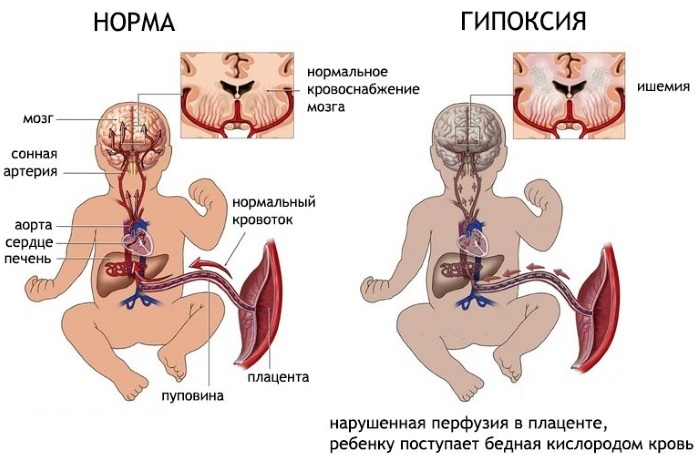During the examination, the doctor can diagnose the headache. presentation of the fetus. Conclusion is the most common and normal physiological situation at 20-34 weeks of gestation. There are several types of cephalic presentation.
However, it should not cause concern. Depending on the type of placement of the baby in the womb, it will be determined whether it is possible to carry out natural childbirth or whether it is best to choose a cesarean section.
Record content:
- 1 What does cephalic presentation mean?
-
2 Types of cephalic presentation and their features
- 2.1 Occipital
- 2.2 Forehead
- 2.3 Facial
- 2.4 Lobnoe
- 2.5 Low head presentation
- 3 Causes of incorrect presentation at 20-30 weeks of pregnancy
- 4 Diagnostics
-
5 How to achieve a cephalic presentation of the fetus
- 5.1 Exercises for cephalic presentation
-
6 How is the delivery going with the head presentation?
- 6.1 Anterior cephalic presentation
- 6.2 Facial presentation
- 6.3 Frontal presentation
- 6.4 Occipital presentation
- 7 Possible complications
- 8 Video about the head presentation of the fetus
What does cephalic presentation mean?
Already at the earliest stage of pregnancy, the child can change its position, and in the second trimester, the fetus begins to turn over at all several times per hour. This is due to the fact that the space of the uterus is not limited to a certain period.
Also, the required amount of amniotic fluid is located around the fetus, which allows it to actually "tumble" in the womb. From the 30th week of pregnancy, the baby's mobility slows down, as he becomes too large to make coups.
Presentation of the fetus is the location of the child relative to the small pelvis, or rather the exit from it. The baby is finally in position by the 34th or 35th week. 80% of babies stop turning by the 23rd or 25th week. They are in a position that is optimal for passage through the birth canal through the pelvis.

The cephalic presentation is considered the most harmonious development and is the optimal position when the child can freely pass through the birth canal and cause the least damage to the woman.
But even if the fetus has been in breech presentation for a long time (that is, in a sitting position), it can still turn around correctly in the last month of pregnancy.
Cephalic presentation of the fetus at 20 weeks is not an accurate diagnosis, but only states what position the fetus is in on the day of examination. After this period, the child can turn over dozens and even hundreds of times. Therefore, even if at first the fetus occupies a position that is not very convenient for childbirth, he can change it on his own.
Types of cephalic presentation and their features
There are several varieties of the location of the fetus in the womb. These types differ, and their precise definition determines whether surgery is required during childbirth.
Occipital
This is the best option, which occurs in more than 90% of cases. With an occipital presentation, the child's head tilts slightly forward so that it will pass through the birth canal with a small fontanel, that is, with the back of the head forward.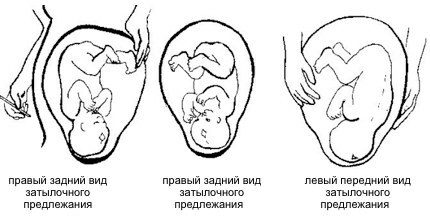
With this position, the likelihood of birth trauma is minimal. Also, with an occipital presentation, the risk of rupture of the vagina or perineum in a future woman in labor is practically excluded.
Forehead
This position is also called the 1st degree of head extension. The child is most likely to move along the birth canal with a second or greater fontanel. This means that the birthing process will take longer, since the area of this part of the head is slightly larger.
However, in this situation, natural childbirth is allowed. But in this case, the likelihood increases that both the woman herself and the child will receive injuries. Another risk is that your contractions may weaken during labor.
This phenomenon is usually called the weakness of the generic forces. If this situation drags on for a rather long period, then there is a risk of oxygen starvation in the child. Therefore, the doctor carefully monitors and assesses the position of the fetus and only then makes the best decision about whether it is worth taking the risk and carrying out natural childbirth.
Facial
This presentation is also called the 3rd degree of head extension. Further, she simply cannot straighten out. In such a situation, the fetus will move its chin forward along the birth canal. In theory, natural childbirth with a facial position is possible. However, this is only allowed in that situation if the child is lightweight, and the woman's pelvis is large enough.
Otherwise, the likelihood of injury is high. With such a diagnosis, doctors most often suggest not to take risks and carry out a cesarean section. This minimizes complications for both the woman in labor and her baby.
Lobnoe
Cephalic presentation of the fetus at 20 weeks of this type is also called the 2nd degree of head extension. This means that the largest part of the fetal head will enter the woman's pelvic area. This can cause not only prolonged labor, but also additional complications. The child in this position will pass through the birth canal with his forehead forward.
This very often causes injury to the spine, spinal cord and even the brain. During labor, acute hypoxia may occur. If it lasts a long time, then this can provoke not only irreversible consequences, but also the death of the child.
If a diagnosis of a frontal presentation is made and natural childbirth is performed, then the woman guaranteed to receive serious injuries up to very dangerous ruptures:
- perineum;
- uterus;
- neck.
Pelvic ligaments can also be damaged. In some situations, it even reached bone fractures. Therefore, with this type of presentation, natural childbirth is extremely dangerous, the doctor insists on performing a cesarean section.
Low head presentation
Typically, it is diagnosed between weeks 20 and 38. With a low cephalic presentation, there is a risk that childbirth will occur prematurely.
Therefore, in such a situation, the best solution would be increased supervision of the woman by the medical staff. Also during pregnancy, it is important to ensure that the uterus and fetus are not adversely affected. To do this, the woman will need to reduce physical activity and rest more often in the supine position.
Not allowed:
- run;
- jump;
- lift weights.
There is also such a thing as cephalic presentation with low placentation. This is a rather dangerous complication during pregnancy, which can appear in absolutely any type of fetal presentation, even if it is located absolutely correctly.
Deviation is characterized by the fact that the placenta is concentrated in the lower part of the uterus near the exit. The fetal head is much higher. With this placement of interest, it begins to overlap the internal pharynx of the uterus, which can cause the development of premature contractions and subsequent childbirth.
If this happens too early, then the underdeveloped fetus may die, firstly, due to hypoxia, and secondly, due to the fact that there is insufficient placental blood circulation.
Fetal death can occur with a probability of 7% to 25%. Another problem is that heavy bleeding can occur with placental presentation. In 2%, this causes the death of a woman. However, there is always the possibility that the placenta will change its position over time. In this case, the danger disappears.
Causes of incorrect presentation at 20-30 weeks of pregnancy
As a rule, such a diagnosis is made if the pregnant woman also had some anatomical features or rather serious health problems.
Most often, the wrong position of the fetus occurs against the background:
- too narrow a pelvis;
- abnormalities in the structure of the uterus;
- presentation with low placentation;
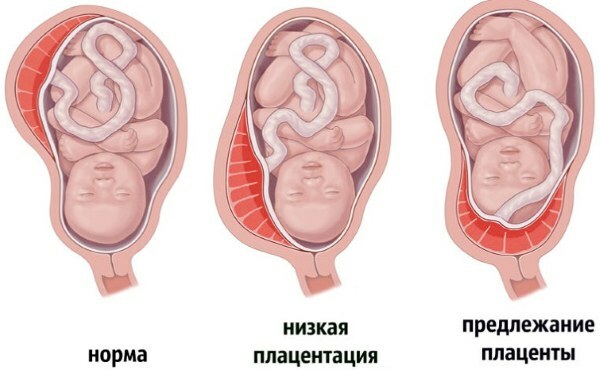
- low muscle tone of the peritoneum;
- the presence of tumors in the uterus.
Even if the baby is positioned absolutely correctly, it can be dangerous when the fetus is in this position too early. If, from the 22nd to the 38th week, it is too close to the pelvis, then this can also play a role and cause premature birth. However, this situation can be corrected by doctors. For this, the woman needs to be admitted to the hospital.
Diagnostics
Cephalic presentation of the fetus at the 20th or later week of pregnancy is determined by ultrasound. But at such an early date, the location of the fetus does not matter.
The ultrasound protocol should indicate the presentation of the fetus, but this is just a description of the position in which the child was at the time when the ultrasound examinations were performed. In general terms, you can determine the type of presentation, starting from the 28th week. In this case, an obstetrician-gynecologist talks to a pregnant woman.
The specialist can use methods of external research. First of all, the height of the uterine fundus is measured. Also, an obstetrician-gynecologist can feel the presenting part through the woman's abdominal cavity.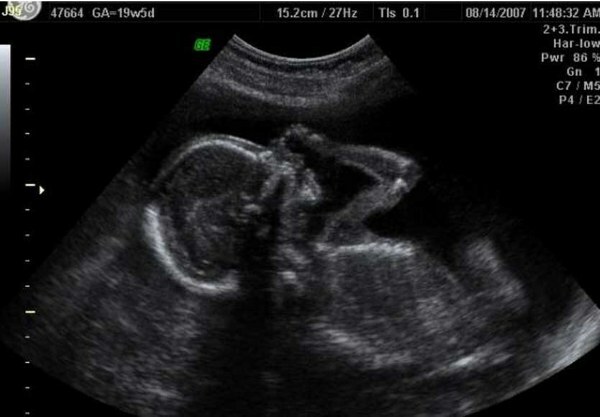
If a breech presentation is diagnosed, then in this case, the buttocks of the fetus will be well felt in the lower abdomen of the patient. The doctor cannot confuse them with the head, since they are less mobile and more soft.
If the location is transverse, then the child's head will be located on the right or left side. Also, with such a diagnosis, a departure from the norms in terms of the standing height of the uterine fundus is often recorded.
The doctor can tell what position the baby is in by listening to the lower abdomen below the navel. If the heartbeat is observed exactly there, then the presentation is headache. With a pelvic or transverse position, the heartbeat will be strongest in the navel area or, conversely, above it.
To do this, at each examination, starting from the 28th week, the obstetrician-gynecologist must not only measure the diameter of the abdomen with a measuring tape, but also feel it to determine in what position it is now fetus.
However, this diagnostics allows only to determine the general features of the situation. The degree of extension of the head cannot be felt even by the best gynecologist. That is why an additional ultrasound is performed. It allows you to clarify the type of cephalic presentation, as well as approximately determine the weight of the unborn child and the structural features of his body.
Only on an ultrasound can you immediately identify that an umbilical cord entanglement has occurred or diagnose placenta previa. Therefore, ultrasound examinations are mandatory in the later stages of pregnancy. Thanks to ultrasound, it is possible to determine whether natural childbirth can be carried out.
How to achieve a cephalic presentation of the fetus
The position of the embryo can be corrected. First of all, a pregnant woman should follow all the doctor's recommendations, rest and not be physically strenuous.
Also, the specialist prescribes gymnastic activities. If this does not help and the location of the child raises serious concerns, then hospitalization is performed, which should be carried out even before the expected birth.
In order to save the life of the child and not harm the woman in labor, an external inversion of the fetus is performed. This is necessary for him to take the correct cephalic presentation. The procedure is for the doctor to point the head of the fetus down. To do this, you will need to unfold his body.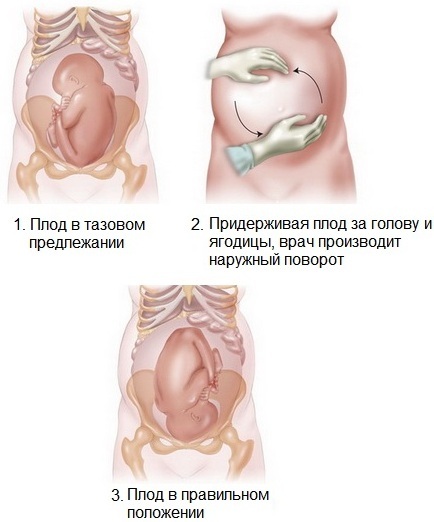
As a rule, an external flip is performed with a transverse presentation only if the abdominal wall is too pliable and the pelvis is normal in size. Also, the procedure can be performed only in that situation if the physical condition of the woman and the fetus itself is assessed as satisfactory.
The bladder must be emptied before the procedure. Also, the doctor must relieve the tone of the uterus and prevent the development of pain. Why an injection is made, consisting of a solution of promedol. As soon as the drug begins to act, the patient is transferred to a couch and laid in a horizontal position on her back, her legs must be bent at the knees.
The gynecologist stands to the right of the patient and places one hand on the place where the child's head is located. After that, he very carefully and gently begins to move it towards the cervix. At the same time, he moves the pelvic end to its bottom.
After that, it is important to fix the cephalic longitudinal presentation. To do this, two rollers are placed on the patient's stomach and bandaged. In this state, a woman should be in the hospital until the birth itself.
Exercises for cephalic presentation
Cephalic presentation of the fetus at 20 weeks can be provoked on its own, but only if such events are approved by the attending physician. There are a number of exercises to help your baby get into the correct position in the womb.
| Exercise type | How to do |
| Coups | It takes 10 minutes. lie first on the right, and then on the left side. Repeat 3-4 times, 2-3 such approaches a day. |
| Knee-elbow position | It is necessary to take a position for 20 minutes. If the knees are 20-30 cm higher than the floor, then the exercise will be more effective. |
| Raising the pelvis | You need to lie on your back and put a pillow under your buttocks. After that, you need to raise the pelvis by about 30 cm and hold this position for 5 minutes. During these lifts, the knees and buttocks should be at the same level.
|
| Leg pulling | It is required to take a horizontal position and roll over on its side. After that, you need to pull your knees to your stomach (not too much so that there is no pressure on the abdominal cavity) and stay in this position for 5 minutes. Next, you need to roll over to the second side and repeat the procedure. |
During the performance of such exercises, in no case should you rush. A woman should be calm, breathing measured. Abrupt movements are excluded. If everything is done correctly, then such activities will help stimulate the motor activity of the fetus.
He will begin to roll over and there will be a chance that he will take the correct cephalic presentation. In case of health problems or, for example, the presence of scars on the uterus, such gymnastics is contraindicated. You also need to exclude such exercise with late toxicosis or placenta previa.
If the presentation cannot be adjusted, then the doctor determines the birth plan depending on the position in which the fetus is located. He must assess all risks and possible deviations.
How is the delivery going with the head presentation?
Delivery depends entirely on the position in which the baby is in the womb. To minimize dangerous situations in breech and transverse presentation, a caesarean section is performed.
Anterior cephalic presentation
In such a situation, the baby will move straight through the birth canal, which can complicate childbirth. If the doctor and the patient decide to give preference to natural childbirth, then it is tedious to prepare for the fact that it will be difficult, very painful and protracted.
During delivery, doctors should prepare equipment in case the fetus develops hypoxia or the woman in labor suffers from severe tears and bleeding. If the threat to the patient's life is high, then operative delivery is performed.
Facial presentation
If the patient has a large pelvis, and the fetus weighs less than 3 kg, then natural childbirth is possible and they can pass quite quickly without serious injuries and risks.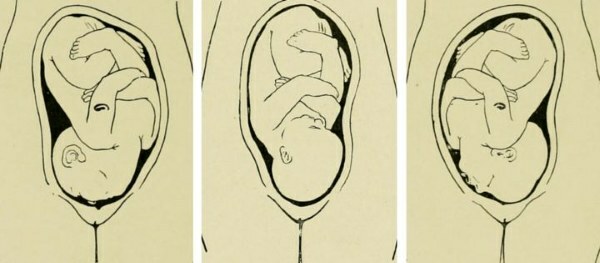 But for women with a narrower pelvis, delivery can be complicated.
But for women with a narrower pelvis, delivery can be complicated.
Frontal presentation
Natural childbirth in this case is the most risky. In order to prevent the death of the fetus and the appearance of ruptures and other injuries in the woman in labor, surgery is performed.
Occipital presentation
In most situations, natural childbirth is recommended, as the baby's head passes quickly through the birth canal. The labor itself can only bring minor damage, which are considered normal in such a process. Caesarean section is prescribed only if there are other contraindications.
Possible complications
Cephalic presentation of the fetus at 20 weeks is not dangerous, but complications can arise if the fetus suddenly begins to change position. If the expectant mother is not diagnosed at a later stage of pregnancy, then it is very difficult to predict the outcome of childbirth.
If a woman receives serious injuries during childbirth, she may suffer from severe bleeding and the appearance of fistulas. This negatively affects her health. Fibroids may develop or the child will not be able to conceive again.
If during natural childbirth the child suffers from hypoxia, this can lead to irreversible changes in development and even a detailed outcome. When diagnosing an extensor cephalic presentation, childbirth at home or in water should be excluded.
This will further aggravate the situation and the chances of a favorable outcome will be less. But even if the child is located optimally comfortably, delivery should take place under the supervision of a doctor who can quickly respond to any unforeseen situation.
As a rule, at the 36th week, doctors recommend deciding on a maternity hospital. Today, women can choose any institution, not necessarily in the region of residence or by registration.
If labor activity began earlier than the expected date, and the patient is delivered to another perinatal center by ambulance, then it is imperative to inform the doctor about the presentation of the fetus. This will save time for the examination. It is advisable to have the results of the last ultrasound with you.
Thus, the cephalic presentation of the fetus can change both at the 20th week and later. It is the variety of the position of the child in the womb that is important. But even in the most difficult situations, if the doctor decides to perform a cesarean section in a timely manner, the risk to the life of a woman and her child is much less.
Video about the head presentation of the fetus
Head presentation of the fetus:



